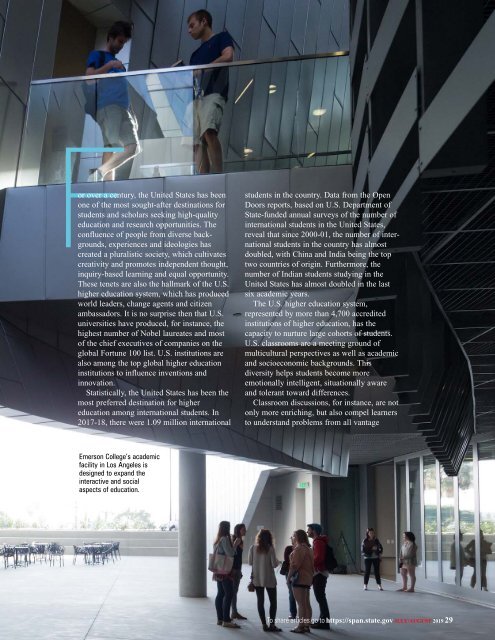July-August 2019
You also want an ePaper? Increase the reach of your titles
YUMPU automatically turns print PDFs into web optimized ePapers that Google loves.
For over a century, the United States has been<br />
one of the most sought-after destinations for<br />
students and scholars seeking high-quality<br />
education and research opportunities. The<br />
confluence of people from diverse backgrounds,<br />
experiences and ideologies has<br />
created a pluralistic society, which cultivates<br />
creativity and promotes independent thought,<br />
inquiry-based learning and equal opportunity.<br />
These tenets are also the hallmark of the U.S.<br />
higher education system, which has produced<br />
world leaders, change agents and citizen<br />
ambassadors. It is no surprise then that U.S.<br />
universities have produced, for instance, the<br />
highest number of Nobel laureates and most<br />
of the chief executives of companies on the<br />
global Fortune 100 list. U.S. institutions are<br />
also among the top global higher education<br />
institutions to influence inventions and<br />
innovation.<br />
Statistically, the United States has been the<br />
most preferred destination for higher<br />
education among international students. In<br />
2017-18, there were 1.09 million international<br />
students in the country. Data from the Open<br />
Doors reports, based on U.S. Department of<br />
State-funded annual surveys of the number of<br />
international students in the United States,<br />
reveal that since 2000-01, the number of international<br />
students in the country has almost<br />
doubled, with China and India being the top<br />
two countries of origin. Furthermore, the<br />
number of Indian students studying in the<br />
United States has almost doubled in the last<br />
six academic years.<br />
The U.S. higher education system,<br />
represented by more than 4,700 accredited<br />
institutions of higher education, has the<br />
capacity to nurture large cohorts of students.<br />
U.S. classrooms are a meeting ground of<br />
multicultural perspectives as well as academic<br />
and socioeconomic backgrounds. This<br />
diversity helps students become more<br />
emotionally intelligent, situationally aware<br />
and tolerant toward differences.<br />
Classroom discussions, for instance, are not<br />
only more enriching, but also compel learners<br />
to understand problems from all vantage<br />
Emerson College’s academic<br />
facility in Los Angeles is<br />
designed to expand the<br />
interactive and social<br />
aspects of education.<br />
To share articles go to https://span.state.gov JULY/AUGUST <strong>2019</strong> 29



